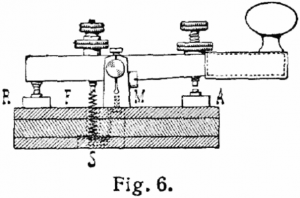The other night my brother in law and I were sitting downstairs playing borderlands 2, or something like that, when we heard a long stream of “dits” and “dahs” manifest itself. Being quite curious as to who was using the code up stairs I went up to find my wife on the phone texting a friend. It wasn’t any kind of code, just a useless means of communication for anything other than jokes; I despise people who want to have long conversation via text, just call me; but I digress. I realized that I haven’t studied up on the topic for some time, probably not since my scouting days, and need some refreshing. While I hate texting, I love the emergency value of knowing Morse Code.
Morse Code is a method for transmitting text information via on-off tones, lights, or clicks that can be directly understood and a listener or observer without special equipment. The international Morse Code utilizes the ISO basic Latin alphabet, a few extra Latin letters, and Arabic numerals, as well as a small set of punctuations and procedural signals all broken down to long signals called “dots” and “dashes”, or “dits” and “dahs”. For some foreign languages extensions of the Morse Code exist.
Each letter or numeral has its own unique sequence of dots and dashes. The duration of a dash is three times the duration of a dot. Each dot or dash is followed by a short silence, equal to the dot duration. The letters of a word are separated by a space equal to three dots (one dash), and the words are separated by a space equal to seven dots. The dot duration is the basic unit of time measurement in code transmission. With that, all you need to do is memorize the sequences. For me and my wife I think I’m going to make flash cards and it can be memorized in just a few sessions over a few days.
While once well-known Morse Code today is most popular among amateur radio operators, although it is no longer required for licensing in most countries. Even pilots and air traffic controllers usually need only a cursory understanding. Aeronautical navigational aids, such as VORs and NDBs, constantly identify in Morse code. Morse Code can be a great aid because it is less sensitive to poor signal conditions, and still comprehensible to other people without decoding; if you can cause a break in an overwhelmingly static transmission on a voice channel, for example, then you can relay a message.
Jon



Leave a Reply